park assist SKODA OCTAVIA TOUR 2009 1.G / (1U) Owner's Manual
[x] Cancel search | Manufacturer: SKODA, Model Year: 2009, Model line: OCTAVIA TOUR, Model: SKODA OCTAVIA TOUR 2009 1.G / (1U)Pages: 224, PDF Size: 13.53 MB
Page 4 of 224
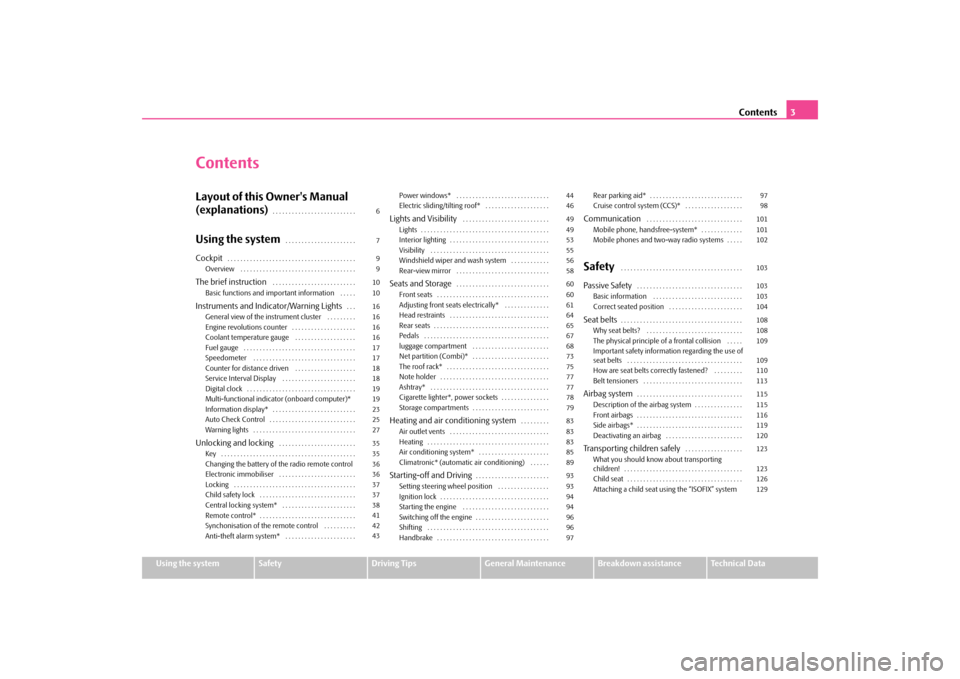
Contents
3
Using the system
Safety
Driving Tips
General Maintenance
Breakdown assistance
Technical Data
ContentsLayout of this Owner's Manual (explanations)
. . . . . . . . . . . . . . . . . . . . . . . . . .
Using the system
. . . . . . . . . . . . . . . . . . . . . .
Cockpit
. . . . . . . . . . . . . . . . . . . . . . . . . . . . . . . . . . . . . . . .
Overview . . . . . . . . . . . . . . . . . . . . . . . . . . . . . . . . . . . . The brief instruction
. . . . . . . . . . . . . . . . . . . . . . . . . .
Basic functions and important information . . . . . Instruments and Indicator/Warning Lights
. . .
General view of the instrument cluster . . . . . . . . . Engine revolutions counter . . . . . . . . . . . . . . . . . . . . Coolant temperature gauge . . . . . . . . . . . . . . . . . . . Fuel gauge . . . . . . . . . . . . . . . . . . . . . . . . . . . . . . . . . . . Speedometer . . . . . . . . . . . . . . . . . . . . . . . . . . . . . . . . Counter for distance driven . . . . . . . . . . . . . . . . . . . Service Interval Display . . . . . . . . . . . . . . . . . . . . . . . Digital clock . . . . . . . . . . . . . . . . . . . . . . . . . . . . . . . . . . Multi-functional indicator
(onboard computer)*
Information display* . . . . . . . . . . . . . . . . . . . . . . . . . . Auto Check Control . . . . . . . . . . . . . . . . . . . . . . . . . . . Warning lights . . . . . . . . . . . . . . . . . . . . . . . . . . . . . . . . Unlocking and locking
. . . . . . . . . . . . . . . . . . . . . . . .
Key . . . . . . . . . . . . . . . . . . . . . . . . . . . . . . . . . . . . . . . . . . Changing the battery of the radio remote controlElectronic immobiliser . . . . . . . . . . . . . . . . . . . . . . . . Locking . . . . . . . . . . . . . . . . . . . . . . . . . . . . . . . . . . . . . . Child safety lock . . . . . . . . . . . . . . . . . . . . . . . . . . . . . . Central locking system* . . . . . . . . . . . . . . . . . . . . . . . Remote control* . . . . . . . . . . . . . . . . . . . . . . . . . . . . . . Synchonisation of the remote control . . . . . . . . . . Anti-theft alarm system* . . . . . . . . . . . . . . . . . . . . . .
Power windows* . . . . . . . . . . . . . . . . . . . . . . . . . . . . . Electric sliding/tilting roof* . . . . . . . . . . . . . . . . . . . . Lights and Visibility
. . . . . . . . . . . . . . . . . . . . . . . . . . .
Lights . . . . . . . . . . . . . . . . . . . . . . . . . . . . . . . . . . . . . . . . Interior lighting . . . . . . . . . . . . . . . . . . . . . . . . . . . . . . . Visibility . . . . . . . . . . . . . . . . . . . . . . . . . . . . . . . . . . . . . Windshield wiper and wash system . . . . . . . . . . . . Rear-view mirror . . . . . . . . . . . . . . . . . . . . . . . . . . . . . Seats and Storage
. . . . . . . . . . . . . . . . . . . . . . . . . . . . .
Front seats . . . . . . . . . . . . . . . . . . . . . . . . . . . . . . . . . . . Adjusting front seats electrically* . . . . . . . . . . . . . . Head restraints . . . . . . . . . . . . . . . . . . . . . . . . . . . . . . . Rear seats . . . . . . . . . . . . . . . . . . . . . . . . . . . . . . . . . . . . Pedals . . . . . . . . . . . . . . . . . . . . . . . . . . . . . . . . . . . . . . . luggage compartment . . . . . . . . . . . . . . . . . . . . . . . . Net partition (Combi)* . . . . . . . . . . . . . . . . . . . . . . . . The roof rack* . . . . . . . . . . . . . . . . . . . . . . . . . . . . . . . . Note holder . . . . . . . . . . . . . . . . . . . . . . . . . . . . . . . . . . Ashtray* . . . . . . . . . . . . . . . . . . . . . . . . . . . . . . . . . . . . . Cigarette lighter*, power sockets . . . . . . . . . . . . . . . Storage compartments . . . . . . . . . . . . . . . . . . . . . . . . Heating and air conditioning system
. . . . . . . . .
Air outlet vents . . . . . . . . . . . . . . . . . . . . . . . . . . . . . . . Heating . . . . . . . . . . . . . . . . . . . . . . . . . . . . . . . . . . . . . . Air conditioning system* . . . . . . . . . . . . . . . . . . . . . . Climatronic* (automatic air conditioning) . . . . . . Starting-off and Driving
. . . . . . . . . . . . . . . . . . . . . . .
Setting steering wheel position . . . . . . . . . . . . . . . . Ignition lock . . . . . . . . . . . . . . . . . . . . . . . . . . . . . . . . . . Starting the engine . . . . . . . . . . . . . . . . . . . . . . . . . . . Switching off the engine . . . . . . . . . . . . . . . . . . . . . . . Shifting . . . . . . . . . . . . . . . . . . . . . . . . . . . . . . . . . . . . . . Handbrake . . . . . . . . . . . . . . . . . . . . . . . . . . . . . . . . . . .
Rear parking aid* . . . . . . . . . . . . . . . . . . . . . . . . . . . . . Cruise control system (CCS)* . . . . . . . . . . . . . . . . . . Communication
. . . . . . . . . . . . . . . . . . . . . . . . . . . . . .
Mobile phone, handsfree-system* . . . . . . . . . . . . . Mobile phones and two-way radio systems . . . . . Safety
. . . . . . . . . . . . . . . . . . . . . . . . . . . . . . . . . . . . . .
Passive Safety
. . . . . . . . . . . . . . . . . . . . . . . . . . . . . . . . .
Basic information . . . . . . . . . . . . . . . . . . . . . . . . . . . . Correct seated position . . . . . . . . . . . . . . . . . . . . . . . Seat belts
. . . . . . . . . . . . . . . . . . . . . . . . . . . . . . . . . . . . . .
Why seat belts? . . . . . . . . . . . . . . . . . . . . . . . . . . . . . . The physical principle of a frontal collision . . . . . Important safety information regarding the use of seat belts . . . . . . . . . . . . . . . . . . . . . . . . . . . . . . . . . . . . How are seat belts correctly fastened? . . . . . . . . . Belt tensioners . . . . . . . . . . . . . . . . . . . . . . . . . . . . . . . Airbag system
. . . . . . . . . . . . . . . . . . . . . . . . . . . . . . . . .
Description of the airbag system . . . . . . . . . . . . . . . Front airbags . . . . . . . . . . . . . . . . . . . . . . . . . . . . . . . . . Side airbags* . . . . . . . . . . . . . . . . . . . . . . . . . . . . . . . . . Deactivating an airbag . . . . . . . . . . . . . . . . . . . . . . . . Transporting children safely
. . . . . . . . . . . . . . . . . .
What you should know about transporting children! . . . . . . . . . . . . . . . . . . . . . . . . . . . . . . . . . . . . . Child seat . . . . . . . . . . . . . . . . . . . . . . . . . . . . . . . . . . . . Attaching a child seat using the “ISOFIX” system
6 7 9 9 10 10 16 16 1616171718181919232527 35 35 3636373738414243
44 46 49 49 53555658 60 60 6164656768737577777879 83 83 838589 93 93 9494969697
97 98 101 101 102 103 103 103 104 108 108 109 109 110113 115 115 116 119 120 123 123 126129
s2g8.b.book Page 3 Tuesday, April 7, 2009 8:53 AM
Page 10 of 224
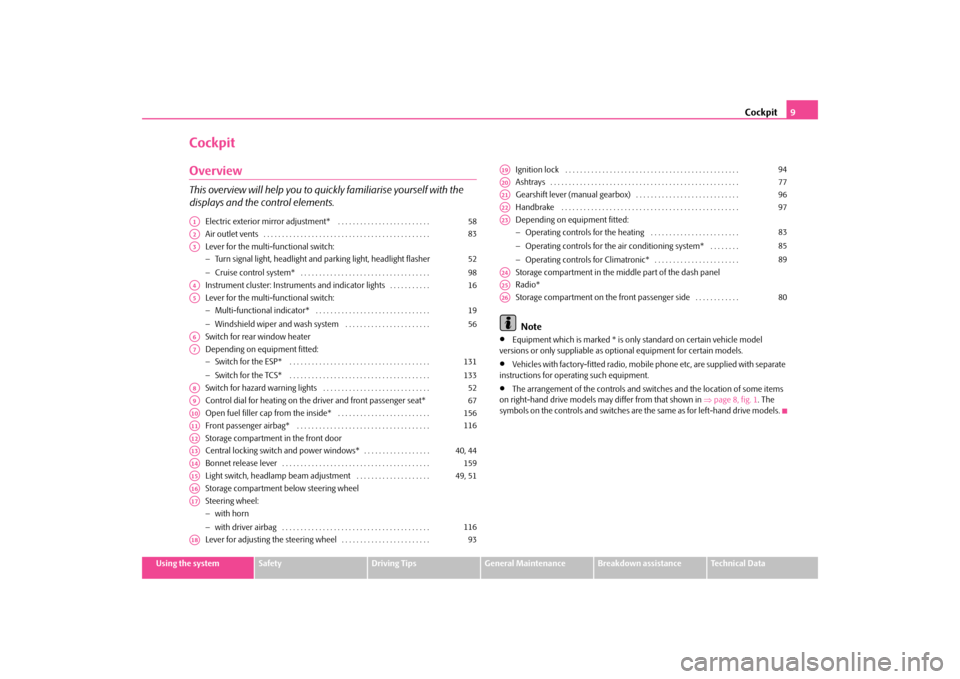
Cockpit
9
Using the system
Safety
Driving Tips
General Maintenance
Breakdown assistance
Technical Data
CockpitOverviewThis overview will help you to quickly familiarise yourself with the displays and the control elements.
Electric exterior mirror adjustment* . . . . . . . . . . . . . . . . . . . . . . . . . Air outlet vents . . . . . . . . . . . . . . . . . . . . . . . . . . . . . . . . . . . . . . . . . . . . . Lever for the multi-functional switch: − Turn signal light, headlight and parking light, headlight flasher − Cruise control system* . . . . . . . . . . . . . . . . . . . . . . . . . . . . . . . . . . . Instrument cluster: Instrum
ents and indicator lights . . . . . . . . . . .
Lever for the multi-functional switch: − Multi-functional indicator* . . . . . . . . . . . . . . . . . . . . . . . . . . . . . . . − Windshield wiper and wash system . . . . . . . . . . . . . . . . . . . . . . . Switch for rear window heater Depending on equipment fitted: − Switch for the ESP* . . . . . . . . . . . . . . . . . . . . . . . . . . . . . . . . . . . . . . − Switch for the TCS* . . . . . . . . . . . . . . . . . . . . . . . . . . . . . . . . . . . . . . Switch for hazard warning lights . . . . . . . . . . . . . . . . . . . . . . . . . . . . . Control dial for heating on the driver and front passenger seat* Open fuel filler cap from the inside* . . . . . . . . . . . . . . . . . . . . . . . . . Front passenger airbag* . . . . . . . . . . . . . . . . . . . . . . . . . . . . . . . . . . . . Storage compartment in the front door Central locking switch and power windows* . . . . . . . . . . . . . . . . . . Bonnet release lever . . . . . . . . . . . . . . . . . . . . . . . . . . . . . . . . . . . . . . . . Light switch, headlamp beam adjustment . . . . . . . . . . . . . . . . . . . . Storage compartment below steering wheelSteering wheel: − with horn − with driver airbag . . . . . . . . . . . . . . . . . . . . . . . . . . . . . . . . . . . . . . . . Lever for adjusting the steering wheel . . . . . . . . . . . . . . . . . . . . . . . .
Ignition lock . . . . . . . . . . . . . . . . . . . . . . . . . . . . . . . . . . . . . . . . . . . . . . . Ashtrays . . . . . . . . . . . . . . . . . . . . . . . . . . . . . . . . . . . . . . . . . . . . . . . . . . . Gearshift lever (manual gearbox) . . . . . . . . . . . . . . . . . . . . . . . . . . . . Handbrake . . . . . . . . . . . . . . . . . . . . . . . . . . . . . . . . . . . . . . . . . . . . . . . . Depending on equipment fitted: − Operating controls for the heating . . . . . . . . . . . . . . . . . . . . . . . . − Operating controls for the air conditioning system* . . . . . . . . − Operating controls for Climatronic* . . . . . . . . . . . . . . . . . . . . . . . Storage compartment in the midd
le part of the dash panel
Radio* Storage compartment on the front passenger side . . . . . . . . . . . . Note
•
Equipment which is marked * is only standard on certain vehicle model
versions or only suppliable as op
tional equipment for certain models.
•
Vehicles with factory-fitted radio, mobi
le phone etc, are supplied with separate
instructions for operating such equipment.•
The arrangement of the controls and swit
ches and the location of some items
on right-hand drive models may differ from that shown in
⇒page 8, fig. 1
. The
symbols on the controls and switches are the same as for left-hand drive models.
A1
58
A2
83
A3
52 98
A4
16
A5
1956
A6A7
131133
A8
52
A9
67
A10
156
A11
116
A12A13
40, 44
A14
159
A15
49, 51
A16A17
116
A18
93
A19
94
A20
77
A21
96
A22
97
A23
838589
A24A25A26
80
s2g8.b.book Page 9 Tuesday, April 7, 2009 8:53 AM
Page 30 of 224
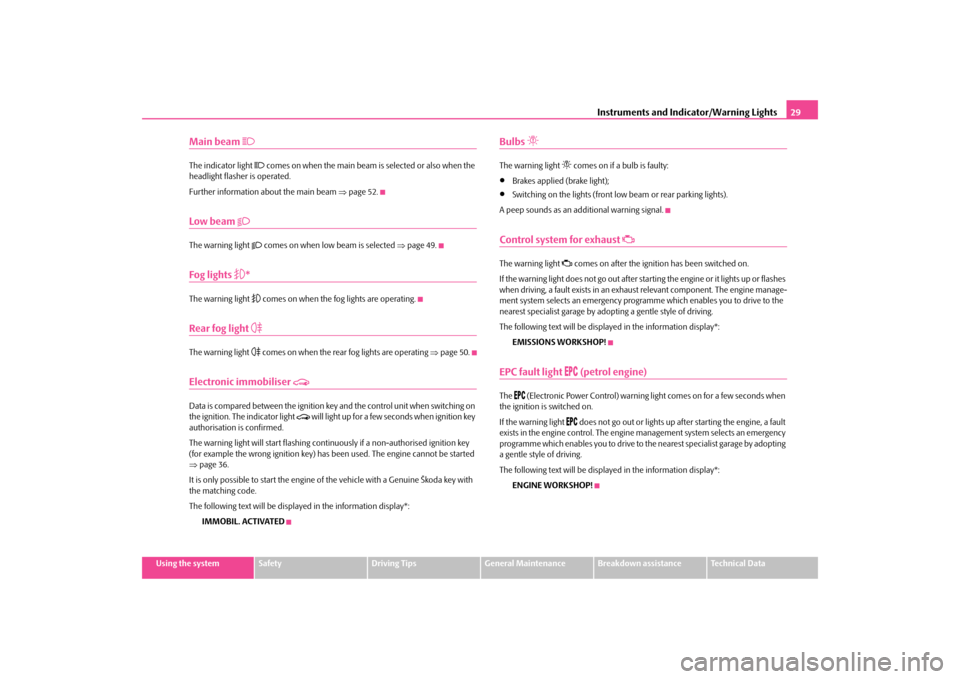
Instruments and Indicator/Warning Lights
29
Using the system
Safety
Driving Tips
General Maintenance
Breakdown assistance
Technical Data
Main beam
The indicator light
comes on when the main beam is selected or also when the
headlight flasher is operated. Further information about the main beam
⇒page 52.
Low beam
The warning light
comes on when low beam is selected
⇒page 49.
Fog lights
*
The warning light
comes on when the fog lights are operating.
Rear fog light
The warning light
comes on when the rear fog lights are operating
⇒page 50.
Electronic immobiliser
Data is compared between the ignition ke
y and the control unit when switching on
the ignition. The indicator light
will light up for a few seconds when ignition key
authorisation is confirmed. The warning light will start flashing conti
nuously if a non-authorised ignition key
(for example the wrong ignition key) has
been used. The engine cannot be started
⇒ page 36. It is only possible to start the engine of
the vehicle with a Genuine Škoda key with
the matching code. The following text will be displayed in the information display*:
IMMOBIL. ACTIVATED
Bulbs
The warning light
comes on if a bulb is faulty:
•
Brakes applied (brake light);
•
Switching on the lights (front low beam or rear parking lights).
A peep sounds as an additional warning signal.Control system for exhaust
The warning light
comes on after the ignition has been switched on.
If the warning light does not go
out after starting the engine
or it lights up or flashes
when driving, a fault exists in an exhaus
t relevant component. The engine manage-
ment system selects an emergency programme which enables you to drive to the nearest specialist garage by adopting a gentle style of driving. The following text will be displayed in the information display*:
EMISSIONS WORKSHOP!
EPC fault light
(petrol engine)
The
(Electronic Power Control) warning light comes on for a few seconds when
the ignition is switched on. If the warning light
does not go out or lights up
after starting the engine, a fault
exists in the engine control. The engine management system selects an emergency programme which enables you to drive to the nearest specialist garage by adopting a gentle style of driving. The following text will be displayed in the information display*:
ENGINE WORKSHOP!
s2g8.b.book Page 29 Tuesday, April 7, 2009 8:53 AM
Page 32 of 224
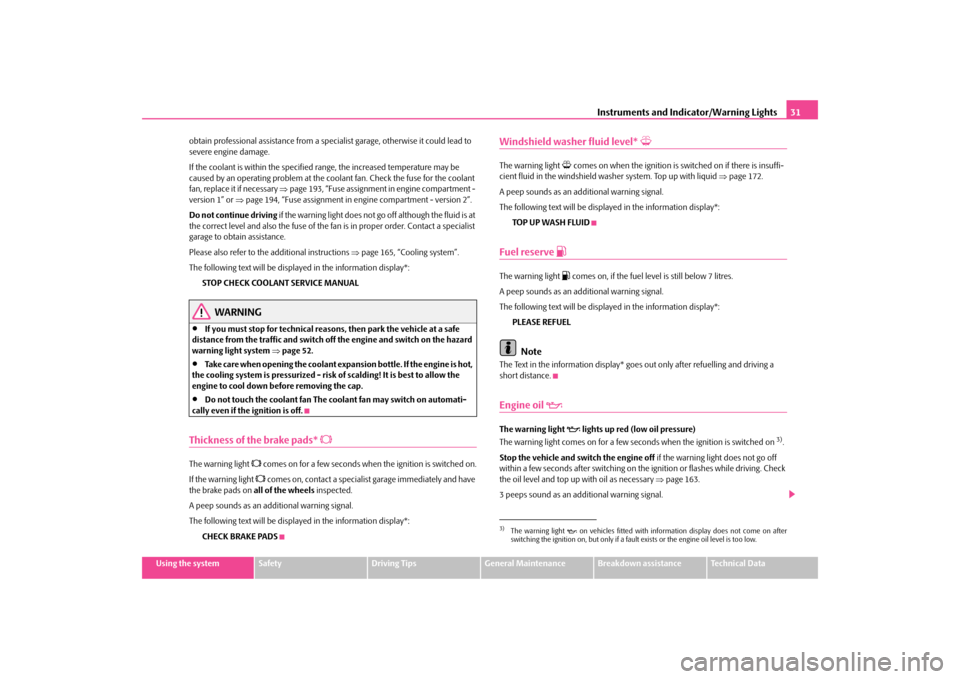
Instruments and Indicator/Warning Lights
31
Using the system
Safety
Driving Tips
General Maintenance
Breakdown assistance
Technical Data
obtain professional assistance from a specialist garage, otherwise it could lead to severe engine damage. If the coolant is within the specified
range, the increased temperature may be
caused by an operating problem at the coolant fan. Check the fuse for the coolant fan, replace it if necessary
⇒page 193, “Fuse assignment in engine compartment -
version 1” or
⇒page 194, “Fuse assignment in en
gine compartment - version 2”.
Do not continue driving
if the warning light does not go
off although the fluid is at
the correct level and also the fuse of the fa
n is in proper order. Contact a specialist
garage to obtain assistance. Please also refer to the additional instructions
⇒page 165, “Cooling system”.
The following text will be displayed in the information display*:
STOP CHECK COOLANT SERVICE MANUAL
WARNING
•
If you must stop for technical reasons, then park the vehicle at a safe
distance from the traffic
and switch off the engine and switch on the hazard
warning light system
⇒page 52.
•
Take care when opening the coolant expa
nsion bottle. If the engine is hot,
the cooling system is pressurized - risk of scalding! It is best to allow the engine to cool down before removing the cap.•
Do not touch the coolant fan The coolant fan may switch on automati-
cally even if the ignition is off.Thickness of the brake pads*
The warning light
comes on for a few seconds when the ignition is switched on.
If the warning light
comes on, contact a specialist garage immediately and have
the brake pads on
all of the wheels
inspected.
A peep sounds as an addi
tional warning signal.
The following text will be displayed in the information display*:
CHECK BRAKE PADS
Windshield washer fluid level*
The warning light
comes on when the ignition is
switched on if there is insuffi-
cient fluid in the windshield washer system. Top up with liquid
⇒page 172.
A peep sounds as an additional warning signal.The following text will be displayed in the information display*:
TOP UP WASH FLUID
Fuel reserve
The warning light
comes on, if the fuel level is still below 7 litres.
A peep sounds as an additional warning signal.The following text will be displayed in the information display*:
PLEASE REFUELNote
The Text in the information display* goes out only after refuelling and driving a short distance.Engine oil
The warning light
lights up red (low oil pressure)
The warning light comes on for a few seconds when the ignition is switched on
3).
Stop the vehicle and sw
itch the engine off
if the warning light does not go off
within a few seconds after switching on the ignition or flashes while driving. Check the oil level and top up with oil as necessary
⇒page 163.
3 peeps sound as an additional warning signal.3)The warning light
on vehicles fitted with information display does not come on after
switching the ignition on, but only if a fault exists or the engine oil level is too low.
s2g8.b.book Page 31 Tuesday, April 7, 2009 8:53 AM
Page 33 of 224
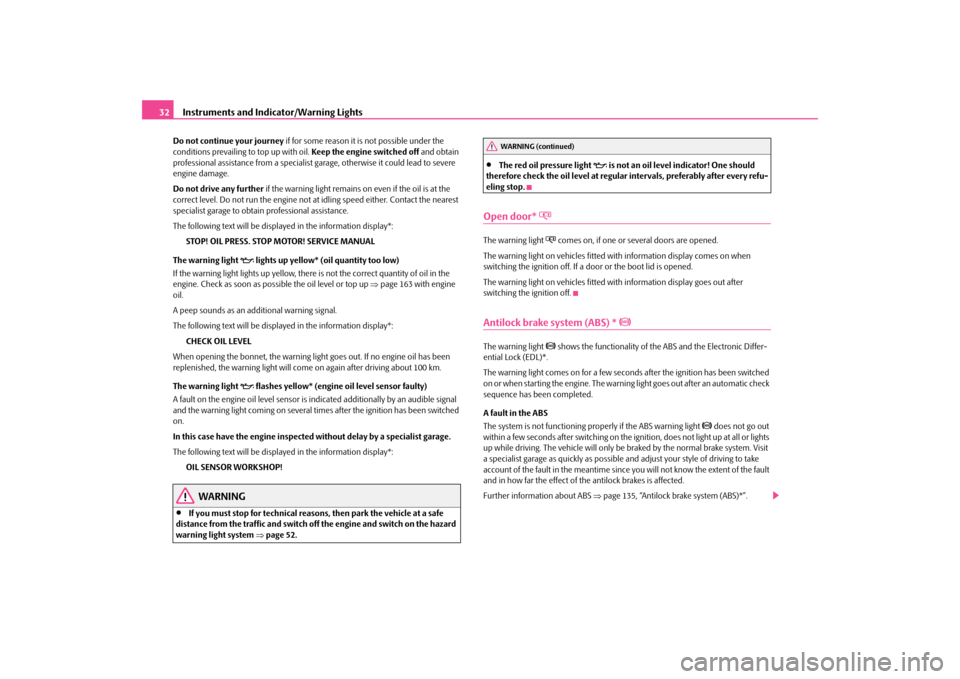
Instruments and Indicator/Warning Lights
32
Do not continue your journey
if for some reason it is not possible under the
conditions prevailing
to top up with oil.
Keep the engine switched off
and obtain
professional assistance from a specialist garage, otherwise it could lead to severe engine damage. Do not drive any further
if the warning light remains on even if the oil is at the
correct level. Do not run the engine not at
idling speed either. Contact the nearest
specialist garage to obtain professional assistance. The following text will be displayed in the information display*:
STOP! OIL PRESS. STOP MOTOR! SERVICE MANUAL
The warning light
lights up yellow* (oil quantity too low)
If the warning light lights up yellow, there is not the correct quantity of oil in the engine. Check as soon as possible the oil level or top up
⇒page 163 with engine
oil. A peep sounds as an additional warning signal.The following text will be displayed in the information display*:
CHECK OIL LEVEL
When opening the bonnet, the warning light
goes out. If no engine oil has been
replenished, the warning light will come on again after driving about 100 km. The warning light
flashes yellow* (engine oil level sensor faulty)
A fault on the engine oil level sensor is in
dicated additionally by
an audible signal
and the warning light coming on several times after the ignition has been switched on. In this case have the engine inspecte
d without delay by a specialist garage.
The following text will be displayed in the information display*:
OIL SENSOR WORKSHOP!
WARNING
•
If you must stop for technical reasons, then park the vehicle at a safe
distance from the traffic and switch off the engine and switch on the hazard warning light system
⇒page 52.
•
The red oil pressure light
is not an oil level indicator! One should
therefore check the oil level at regular
intervals, preferably after every refu-
eling stop.Open door*
The warning light
comes on, if one or several doors are opened.
The warning light on vehicles fitted with information display comes on when switching the ignition off. If a door or the boot lid is opened. The warning light on vehicles fitted with information display goes out after switching the ignition off.Antilock brake system (ABS) *
The warning light
shows the functionality of the ABS and the Electronic Differ-
ential Lock (EDL)*. The warning light comes on for a few seconds after the ignition has been switched on or when starting the engine. The warnin
g light goes out after an automatic check
sequence has been completed. A fault in the ABS The system is not functioning properly if the ABS warning light
does not go out
within a few seconds after switching on the ig
nition, does not light up at all or lights
up while driving. The vehicle
will only be braked by th
e normal brake system. Visit
a specialist garage as quickly as possible and adjust your style of driving to take account of the fault in the meantime since
you will not know the extent of the fault
and in how far the effect of the antilock brakes is affected. Further information about ABS
⇒page 135, “Antilock brake system (ABS)*”.
WARNING (continued)
s2g8.b.book Page 32 Tuesday, April 7, 2009 8:53 AM
Page 50 of 224
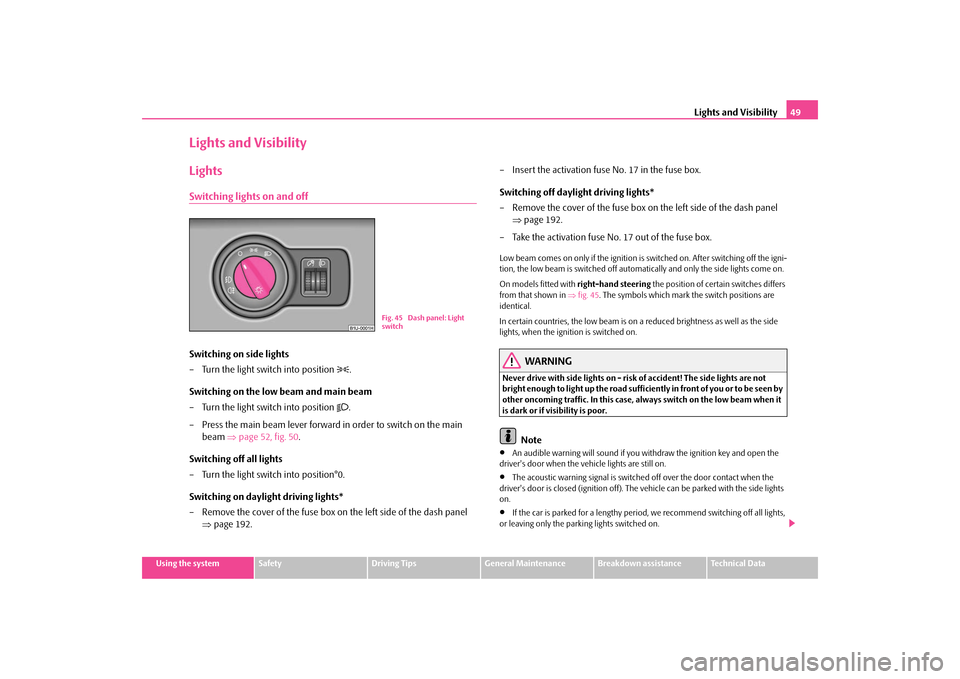
Lights and Visibility
49
Using the system
Safety
Driving Tips
General Maintenance
Breakdown assistance
Technical Data
Lights and VisibilityLightsSwitching lights on and offSwitching on side lights – Turn the light switch into position
.
Switching on the low beam and main beam – Turn the light switch into position
.
– Press the main beam lever forward in order to switch on the main
beam
⇒
page 52, fig. 50
.
Switching off all lights – Turn the light switch into position°0. Switching on daylight driving lights* – Remove the cover of the fuse box on the left side of the dash panel
⇒
page 192.
– Insert the activation fuse No. 17 in the fuse box. Switching off daylight driving lights* – Remove the cover of the fuse box on
the left side of the dash panel
⇒
page 192.
– Take the activation fuse No. 17 out of the fuse box.Low beam comes on only if the ignition is
switched on. After switching off the igni-
tion, the low beam is switched off automati
cally and only the side lights come on.
On models fitted with
right-hand steering
the position of certain switches differs
from that shown in
⇒fig. 45
. The symbols which mark the switch positions are
identical. In certain countries, the low beam is on a
reduced brightness as well as the side
lights, when the ignition is switched on.
WARNING
Never drive with side lights on - risk of accident! The side lights are not bright enough to light up the road suffic
iently in front of you or to be seen by
other oncoming traffic. In this case, always switch on the low beam when it is dark or if visibility is poor.
Note
•
An audible warning will sound if you wi
thdraw the ignition key and open the
driver's door when the vehicle lights are still on.•
The acoustic warning signal is switched off over the door contact when the
driver's door is closed (ignition off). The
vehicle can be parked
with the side lights
on.•
If the car is parked for a lengthy period
, we recommend switching off all lights,
or leaving only the parking lights switched on.
Fig. 45 Dash panel: Light switch
s2g8.b.book Page 49 Tuesday, April 7, 2009 8:53 AM
Page 54 of 224
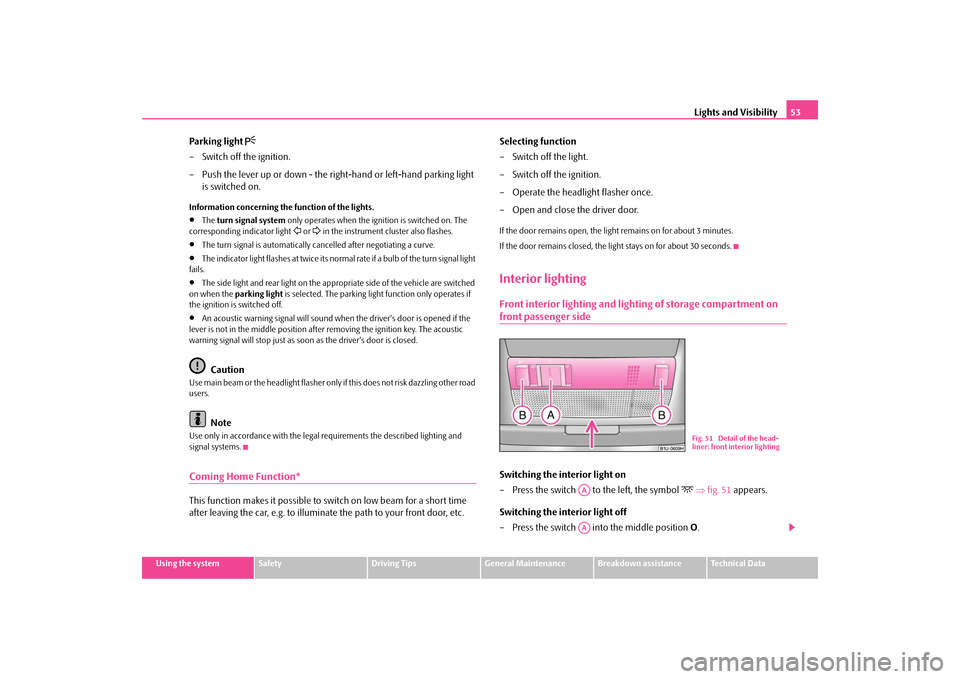
Lights and Visibility
53
Using the system
Safety
Driving Tips
General Maintenance
Breakdown assistance
Technical Data
Parking light
– Switch off the ignition. – Push the lever up or down - the ri
ght-hand or left-hand parking light
is switched on.
Information concerning the function of the lights.•
The
turn signal system
only operates when the ignition is switched on. The
corresponding indicator light
or in the instrument cluster also flashes.
•
The turn signal is automatically cancelled after negotiating a curve.
•
The indicator light flashes at twice its normal
ra te if a bulb of the turn s ignal lig ht
fails.•
The side light and rear light on the appropriate side of the vehicle are switched
on when the
parking light
is selected. The parking light function only operates if
the ignition is switched off.•
An acoustic warning signal will sound when the driver's door is opened if the
lever is not in the middle position after
removing the ignition key. The acoustic
warning signal will stop just as soon
as the driver's door is closed.
Caution
Use main beam or the headlight flasher only
if this does not risk dazzling other road
users.
Note
Use only in accordance with the legal
requirements the described lighting and
signal systems.Coming Home Function*This function makes it possible to switch on low beam for a short time after leaving the car, e.g. to illumina
te the path to your front door, etc.
Selecting function – Switch off the light. – Switch off the ignition. – Operate the headlight flasher once.– Open and close the driver door.If the door remains open, the light remains on for about 3 minutes. If the door remains closed, the light stays on for about 30 seconds.Interior lightingFront interior lighting and lighting of storage compartment on front passenger sideSwitching the interior light on – Press the switch to the left, the symbol
⇒
fig. 51
appears.
Switching the interior light off – Press the switch into the middle position
O.Fig. 51 Detail of the head- liner: front interior lighting
AAAA
s2g8.b.book Page 53 Tuesday, April 7, 2009 8:53 AM
Page 78 of 224

Seats and Storage
77
Using the system
Safety
Driving Tips
General Maintenance
Breakdown assistance
Technical Data
WARNING
•
Do not place any hot beverages into th
e cup holder. If the vehicle moves,
the hot beverages may spill - risk of scalding!•
Do not use any cups or beakers which
are made of brittle material (e.g.
glass, porcelain). You might be injured
by them in the event of an accident.
Caution
Do not open the beverages in the cup holder while driving. They may spill when braking and while doing so damage the vehicle.Note holderThe note holder is designed e.g. for atta
ching a car park ticket in parking areas.
The attached note has to always be
removed
before starting off in order not to
restrict the driver's vision.
Ashtray*Front ashtrayOpening ashtray – Press on the bottom part of the cover of the ashtray at the point of the
arrow
⇒
fig. 88
.
Removing ashtray insert – Remove the ashtray insert in direction of arrow .
Fig. 87 Windscreen: Note holder
Fig. 88 Centre console: Front ashtrayFig. 89 Remove ashtray and replaceAA
s2g8.b.book Page 77 Tuesday, April 7, 2009 8:53 AM
Page 98 of 224
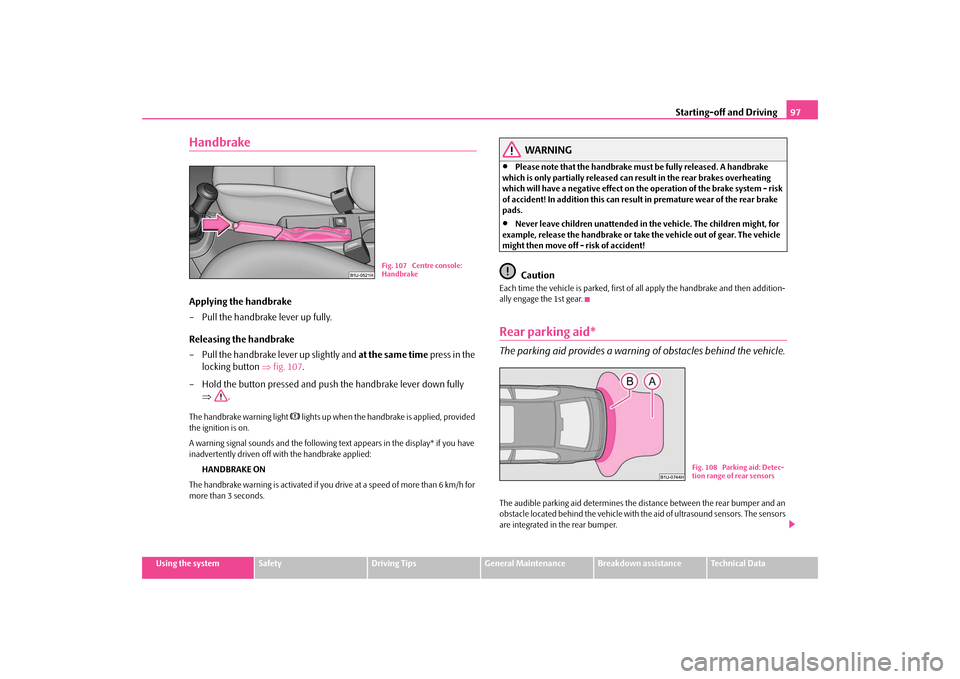
Starting-off and Driving
97
Using the system
Safety
Driving Tips
General Maintenance
Breakdown assistance
Technical Data
HandbrakeApplying the handbrake – Pull the handbrake lever up fully. Releasing the handbrake – Pull the handbrake lever up slightly and
at the same time
press in the
locking button
⇒
fig. 107
.
– Hold the button pressed and push the handbrake lever down fully
⇒
.
The handbrake warning light
lights up when the handbrake is applied, provided
the ignition is on. A warning signal sounds and the following text appears in the display* if you have inadvertently driven off with the handbrake applied:
HANDBRAKE ON
The handbrake warning is activated if you drive at a speed of more than 6 km/h for more than 3 seconds.
WARNING
•
Please note that the handbrake must be fully released. A handbrake
which is only partially released can re
sult in the rear brakes overheating
which will have a negative effect on th
e operation of the brake system - risk
of accident! In addition this can result in premature wear of the rear brake pads.•
Never leave children unattended in the vehicle. The children might, for
example, release the handbrake or take
the vehicle out of gear. The vehicle
might then move off - risk of accident!
Caution
Each time the vehicle is parked, first of
all apply the handbrake and then addition-
ally engage the 1st gear.Rear parking aid*The parking aid provides a warning of obstacles behind the vehicle.The audible parking aid determines the distance between the rear bumper and an obstacle located behind the vehicle with th
e aid of ultrasound sensors. The sensors
are integrated in the rear bumper.
Fig. 107 Centre console: Handbrake
Fig. 108 Parking aid: Detec-tion range of rear sensors
s2g8.b.book Page 97 Tuesday, April 7, 2009 8:53 AM
Page 148 of 224

Taking care of your vehicle and cleaning the vehicle
147
Using the system
Safety
Driving Tips
General Maintenance
Breakdown assistance
Technical Data
General MaintenanceTaking care of your vehicle and cleaning the vehicleGeneralProper care retains the value of your vehicle.Regular and proper care retains
the value
of your vehicle. It may also be one of the
requirements for the acceptance of warran
ty claims relating to corrosion damage
and paint defects on the bodywork. We recommend using a preservative from
Škoda genuine accessories offered by
your Škoda dealer. Please follow the instructions for use on the package.
WARNING
•
Care products may be harmful to your health if not used according to the
instructions.•
Always store care products in a safe place, out of the reach of children -
risk of poisoning!
For the sake of the environment
•
Always select environmentally-friendly pr
oducts when purcha
sing vehicle care
products.•
Do not dispose of the packages with re
sidues of care products in domestic
waste.
Care of the exterior of vehicleWashing the vehicle Frequent washing protects your vehicle.The best protection for your vehicle agai
nst harmful environmen
tal influences is
frequent
washing and wax treatment. How of
ten you should wash your vehicle
depends on a wide range of factors, such as:•
Frequency of use,
•
The parking situation (garage, below trees etc.),
•
Season of the year,
•
Weather conditions,
•
Environmental influences.
The longer insect residues, bird droppings,
tree sap, road and industrial dust, tar,
soot particles, road salt and other aggressive deposits remain adhering to the paint- work of your vehicle, the more detrimental their destructive effect can be. High temperatures, such as those caused by in
tensive sun's rays, accentuate this caustic
effect. It may therefore be necessary, in certain circumstances, to wash the car
once a
week
. It may also be sufficient, however, to wash the car
once a month
followed
by appropriate wax treatment. It is essential to also thoroughly wash the
underside of your vehicle
at the end of
the winter road salting and gritting period.
WARNING
When washing your vehicle in the wint
er: Water and ice in the brake system
can affect the braking efficiency - risk of accident!
s2g8.b.book Page 147 Tuesday, April 7, 2009 8:53 AM